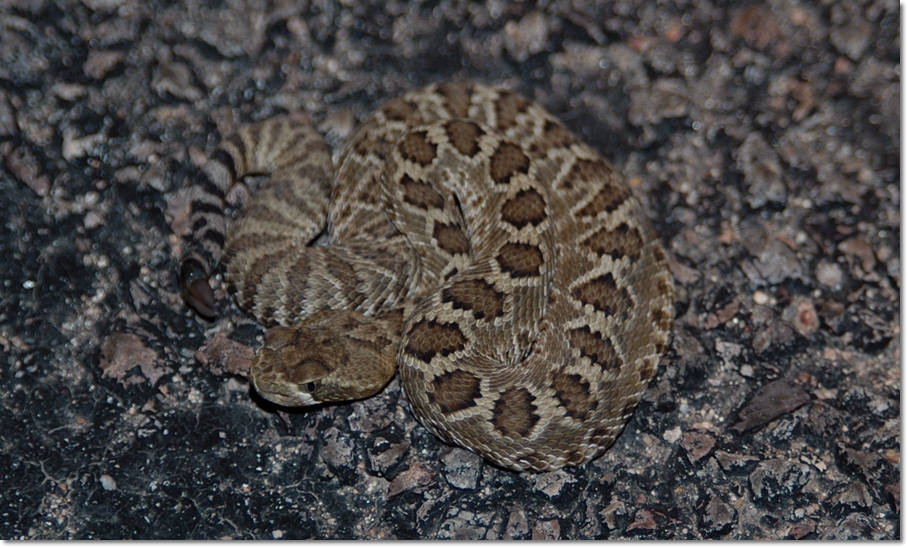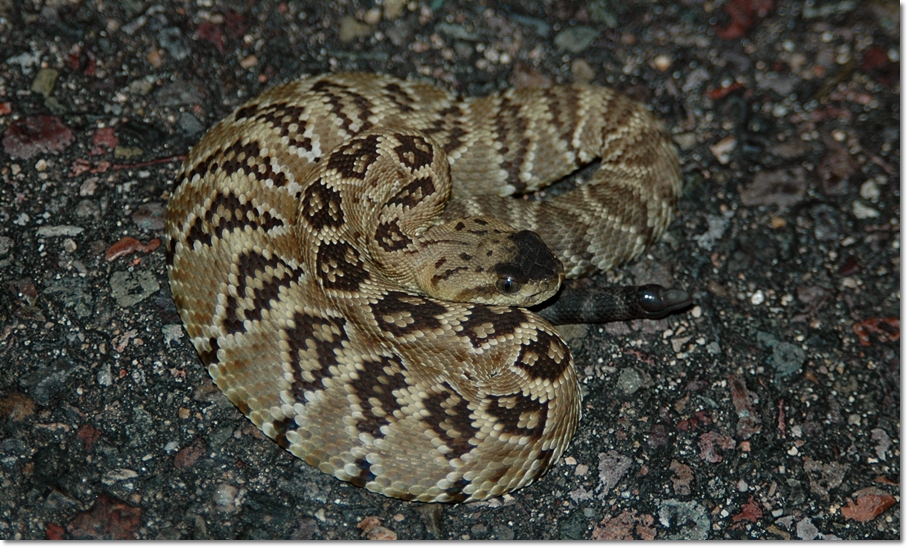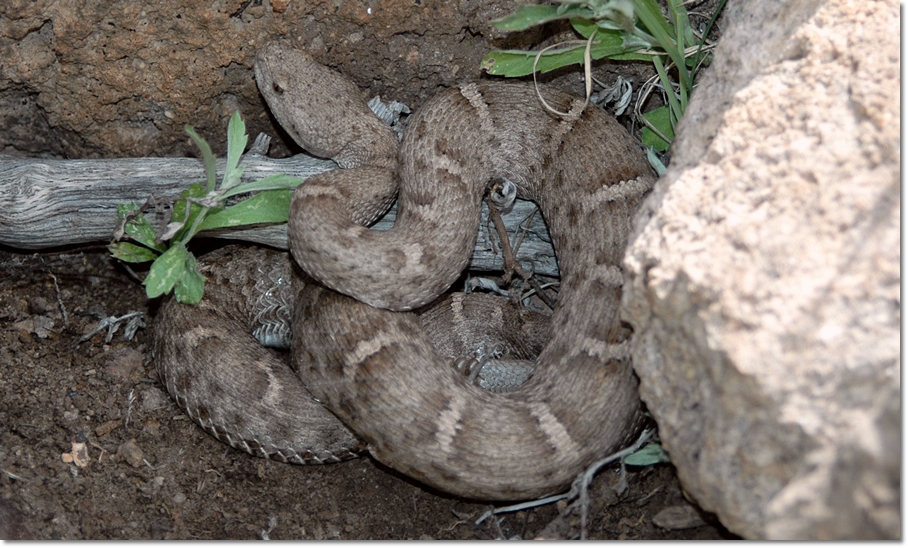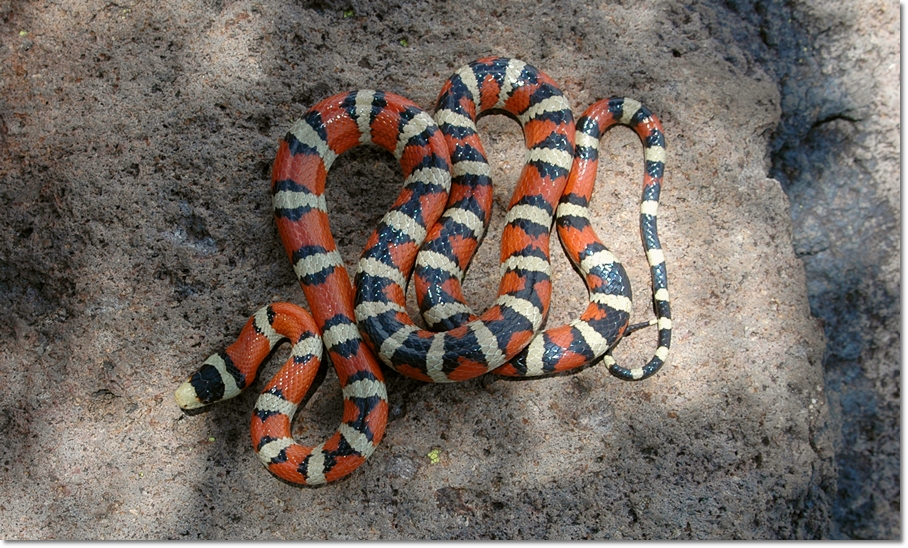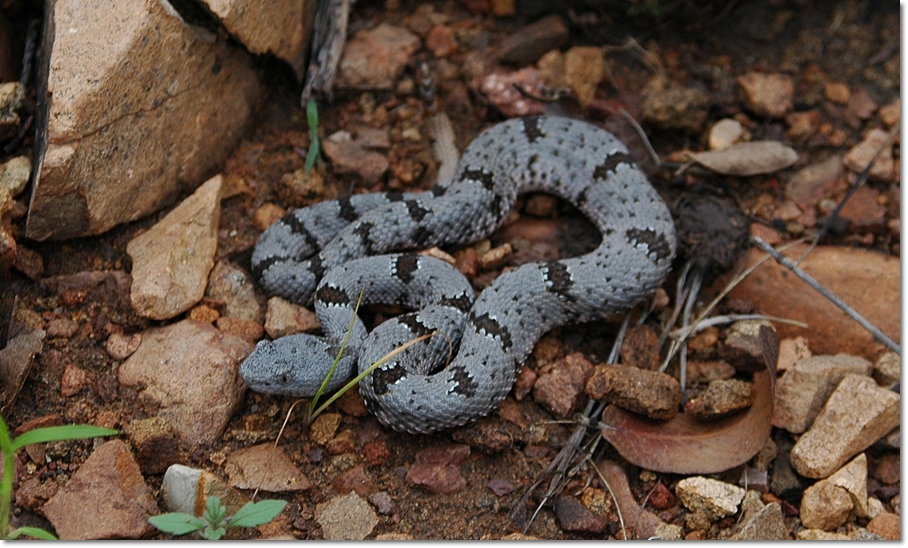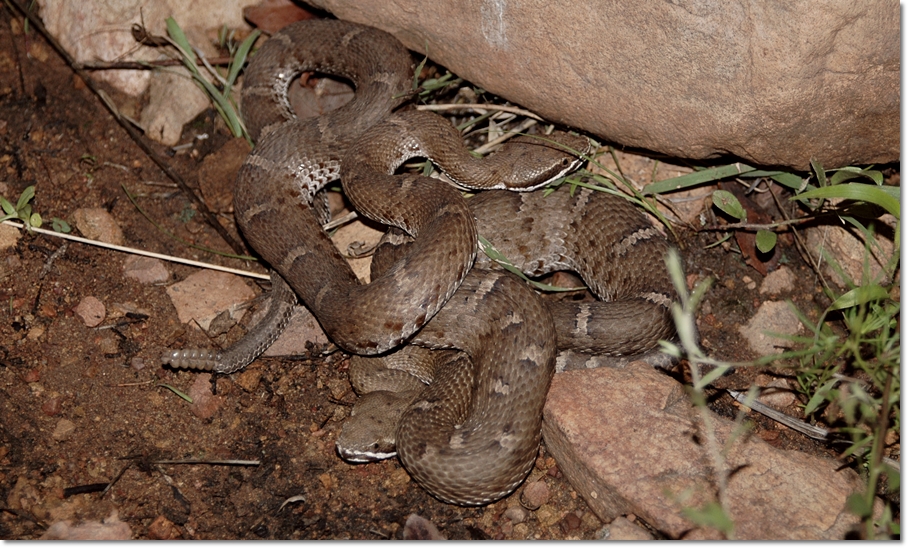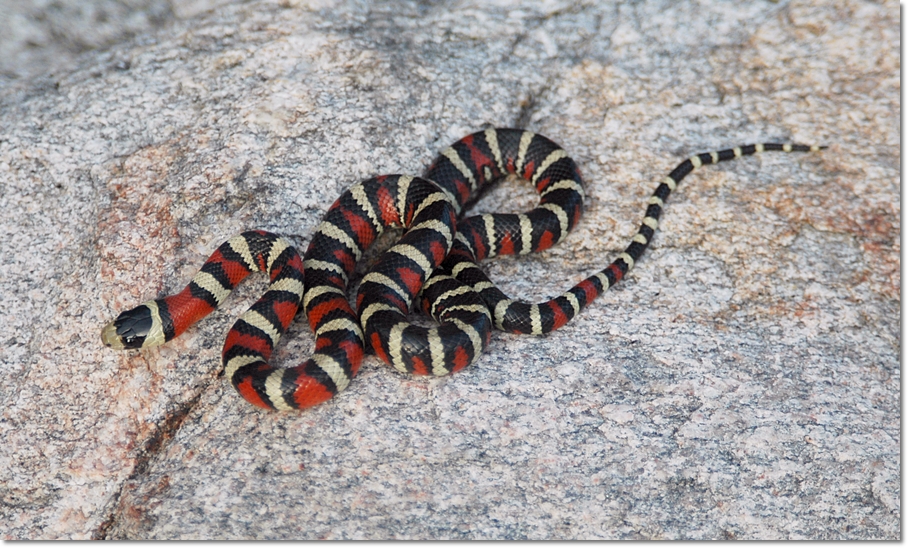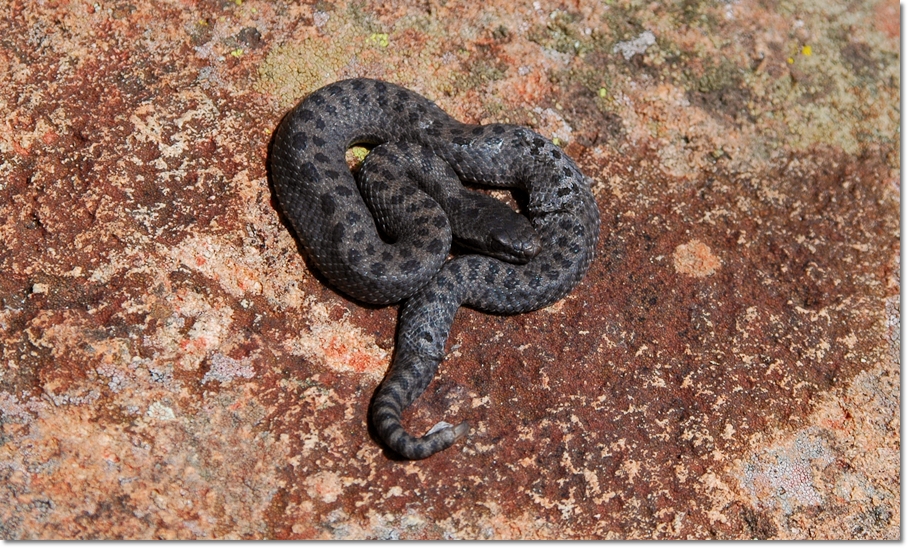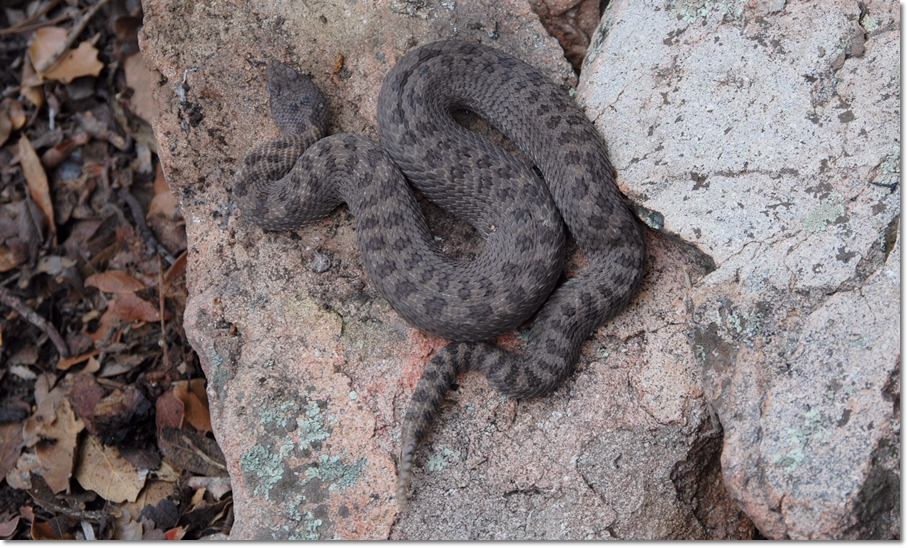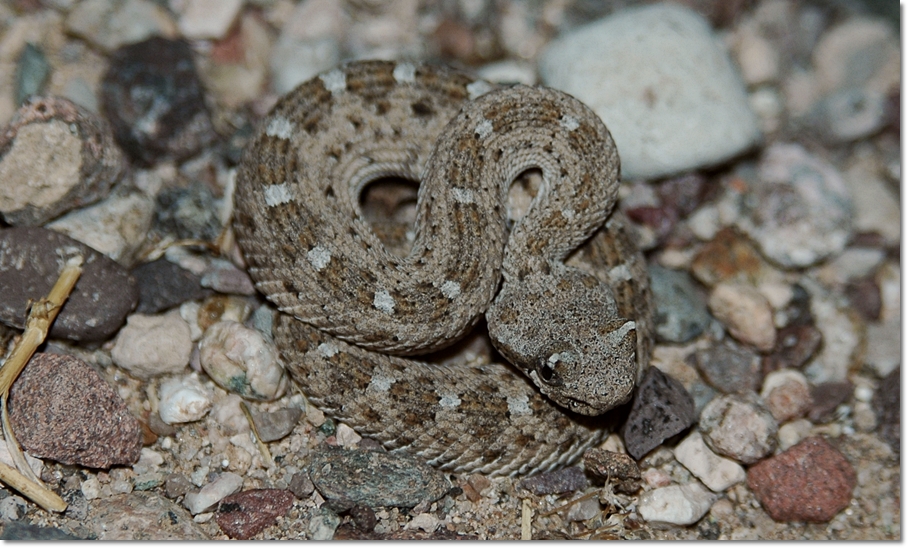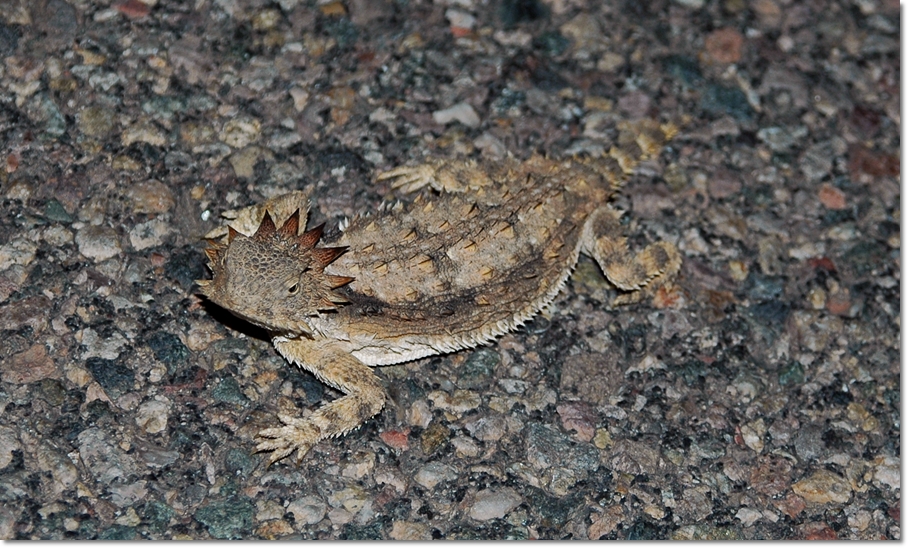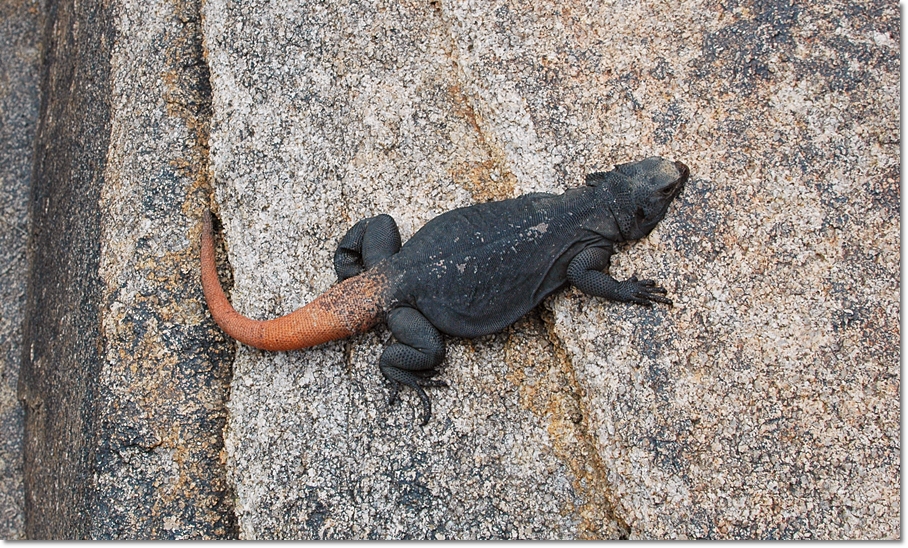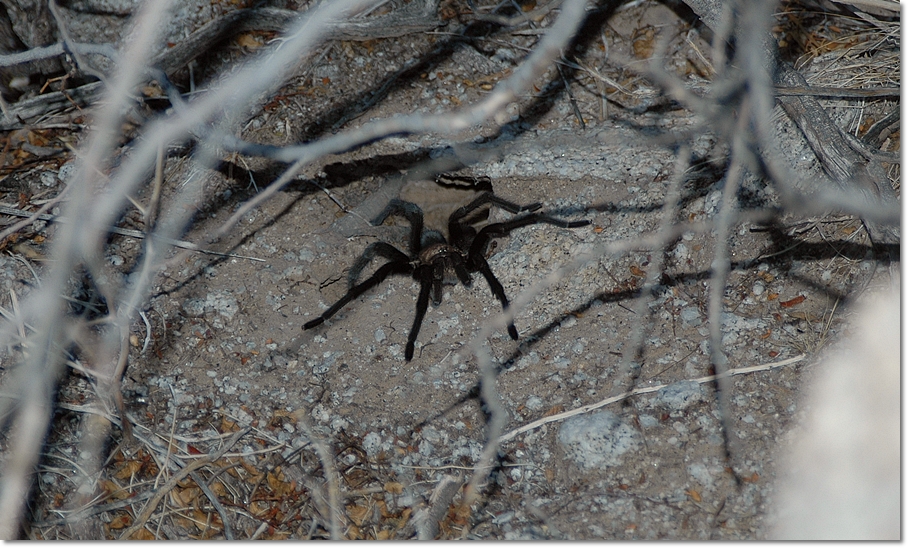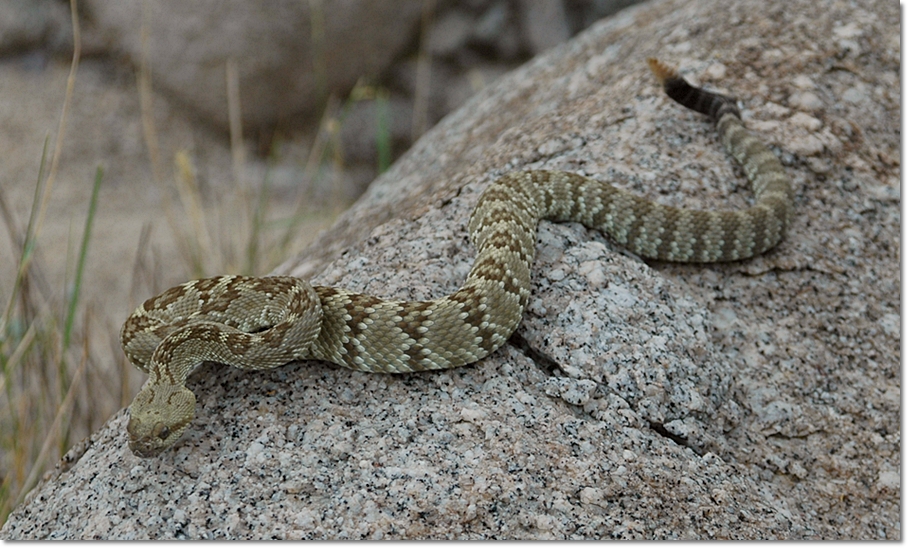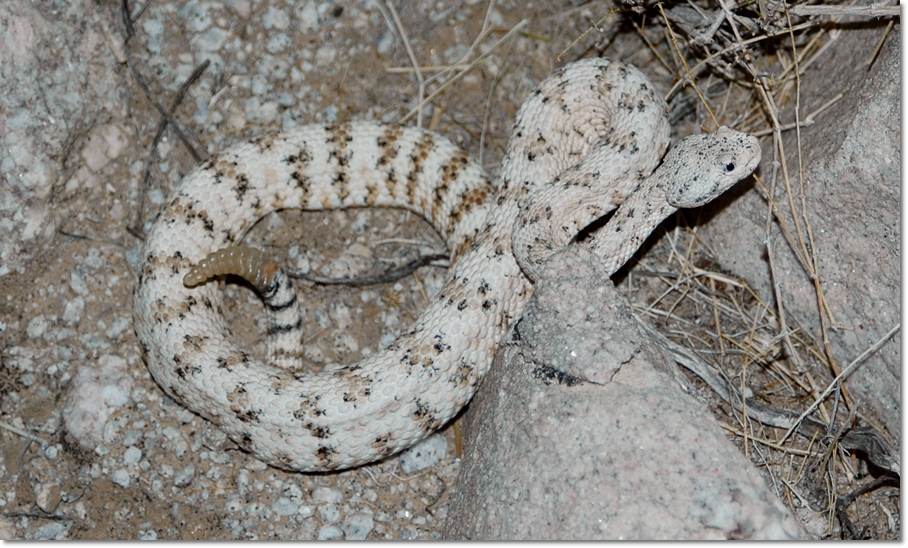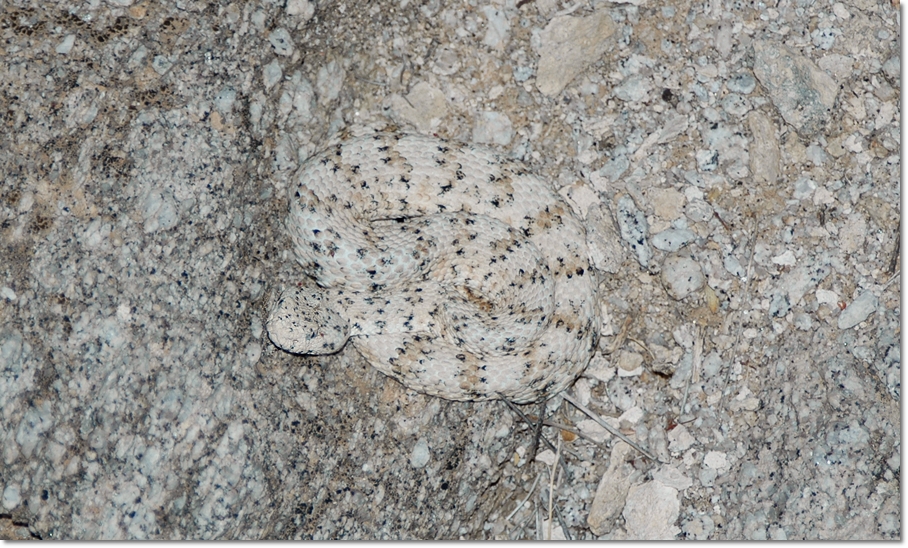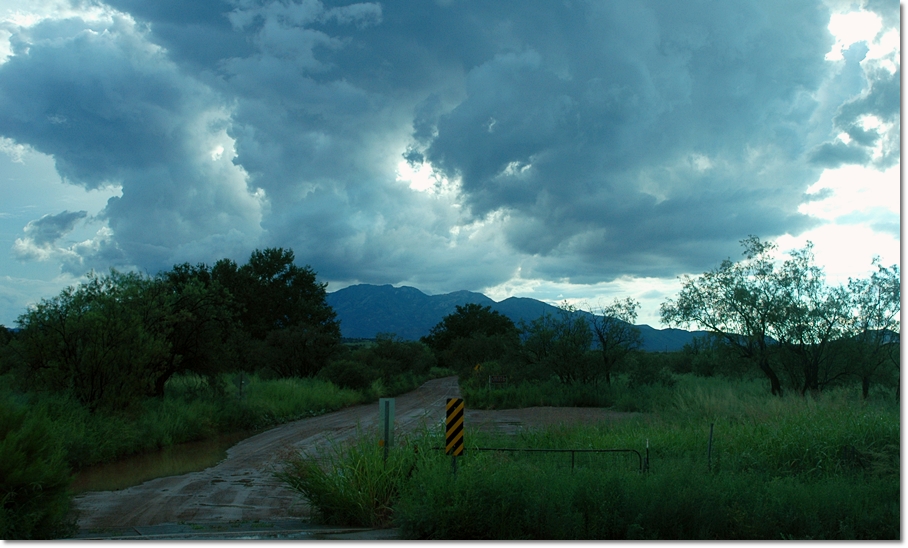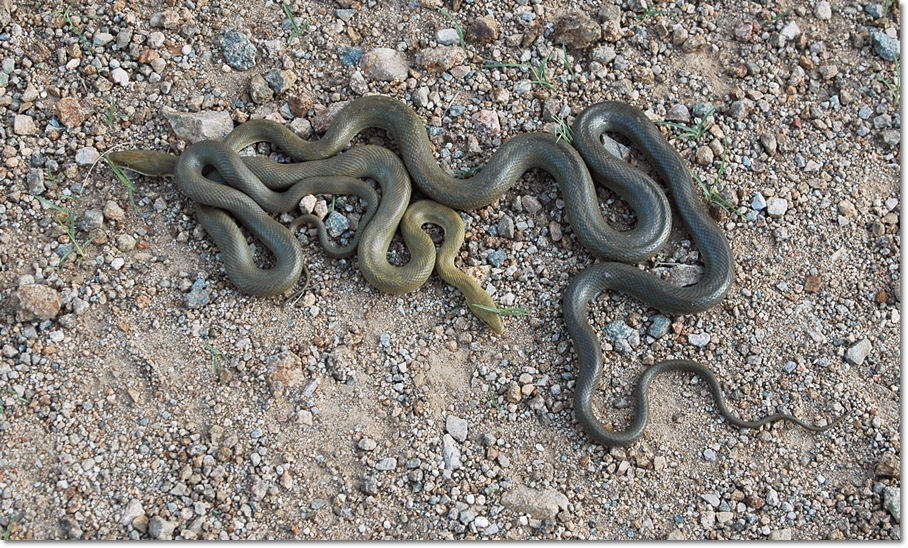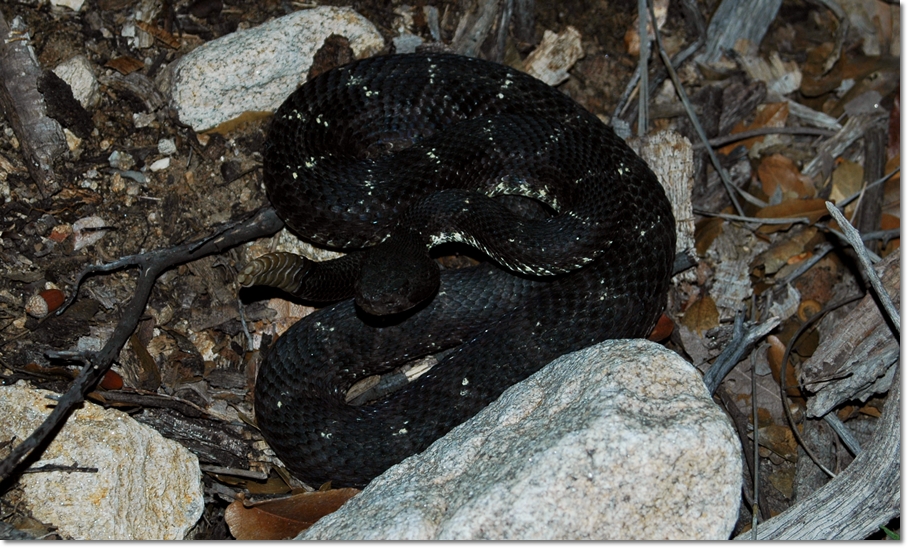
 |
 |
 |
 |
 |
 |
 |
 |
 |
 |
 |
August of 2008 was the first time I actually met Derek in person. I had known him for a long time via the internet and had herped with his brother, York after York moved to New Mexico earlier in 2008. This trip was a great combo of luck, timing and good times. I picked Derek up at the airport and we headed down to SW New Mexico to meet up with York. We headed out to SE AZ in hopes of finding a Twin-spotted Rattlesnake the first evening but were skunked in the Chiricahuas. That evening, we cruised the famous Highway 80 and found several neonate crotes including many Mojave Rattlesnakes (Crotalus scutulatus scutulatus).
It got to the point where we were stopping so often that we would just have Derek go out and kick them off the road. We stopped for another one. But this time Derek said it wasn't a scute. It was a neonate Northern Blacktail Rattlesnake (Crotalus molossus molossus) on the road quite some distance from any hill or canyon.
We were off to a solid start. That evening, we headed back east into the Peloncillo Mountains of SW New Mexico to meet up with other friends to look for the New Mexico Ridgenose Rattlesnake (Crotalus willardi obscurus); likely the rarest rattlesnake in the United States. This subspecies of the ridgenose rattlesnake is known only from two mountain ranges in the United States. The Animas Mountains, where they are more commonly seen, is surrounded by lots of private land and difficult for regular herpers to get access to. The Peloncillos, however, are accessible. But obscurus is a harder get in this lower, drier range. So with some obscurus finding tips in our brains thanks to Chip, a group of us headed out early in the morning and spread out across the canyons. York, Derek and I worked up a hillside that was still in the shadows. As the sun was beginning to make its presence known on the rocks, I decided to drop down to the better looking (or what I thought was better looking) willie habitat. As I was walking, I heard the magical buzzing sound of a rattlesnake. It could have been one of several species from the Northern Blacktail to the Banded Rock to the New Mexico Ridgenose. I would have been very excited to see my first Peloncillo Banded Rock Rattlesnake snake but instead it was a large male New Mexico Ridgenose Rattlesnake. Wow! Wow! Wow! I called for York, who was close by and then hollered for the others in the group. I might have let out a girlish squeel or two :) It was a large adult male with a decent scar on him. Chip said it was the largest obscurus he had ever seen.
Pretty much as good as it gets. Well... almost. As I was watching the others work their way up the hillside towards the snake, I see Ross bend down just about 30 feet from me and go "pyro!" Yup, he had come across a Peloncillo locality Arizona Mountain Kingsnake (Lampropeltis pyromelana pyromelana) on his way up to see the ridgenose. And it was a looker!
York and Derek managed to snag this beautiful Sonoran Whipsnake (Coluber bilineatus) on the way back to the truck. Here they are photographing it. 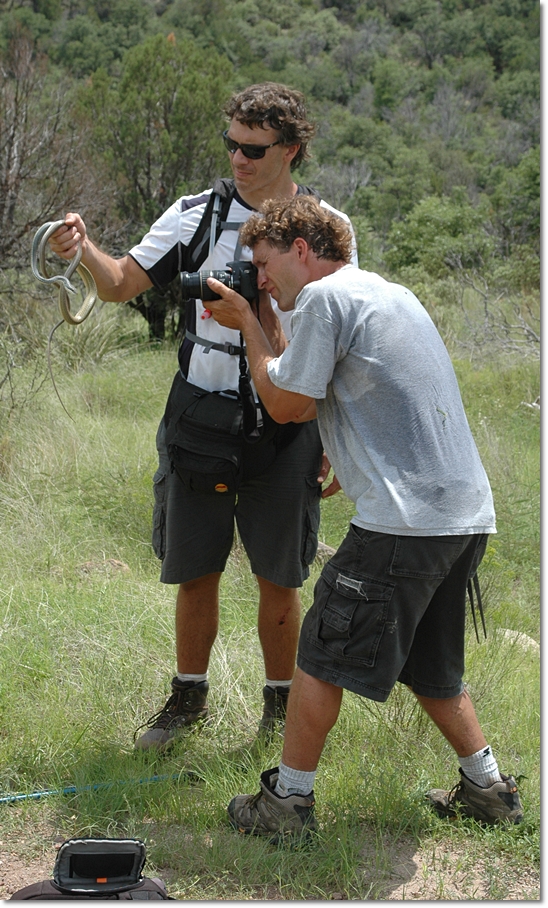 By this time, it was already late morning/early afternoon. We thought we would try to go for the double willardi feat so we drove westward and headed to the Huachucas. We arrived at the Huachucas in the late afternoon/early evening. We quickly buzzed up three Banded Rock Rattlesnakes (Crotalus lepidus klauberi). These animals all had a bluish tint to them - similar to the first ever klaub I found a few years before in the same Huachuca mountains.
It was getting pretty dark now with the sun beginning to set and our hope of turning up a willie was setting as well. That was when Derek yelled "got a willardi". But he was wrong. He didn't get one willardi. He had actually come across a pair of Arizona Ridgenose Rattlesnakes (Crotalus willardi willardi) laying together. That's pretty darn cool to be able to see both ridgenose rattlesnakes subspecies in the United States in the same day.
The next day saw us driving just a bit further north to hit the Santa Ritas. This range is a bit different from the Chiricahuas and the Huachucas in that on the western slopes you can also find Tiger Rattlesnakes in the Ritas. But this day, we were heading up high into the canyons on the east side to look for the last of the montanes: the Twin-spotted Rattlesnake (Crotalus pricei pricei). It was a brutal hike deep into the mountain range with quite the elevation gain. But it started off well. Shortly after we had parked the truck and started hiking, I watched as York said "pyro" and picks one up crossing the path in front of him. Geez!
We made it up to these beautiful talus slides that screamed pricei and they did not disappoint.  We were promptly buzzed by a twin-spot. You can usually tell the difference between twin-spots and klaubs in talus in that twin-spots will usually buzz briefly and then dive and stop buzzing. Klaubs on the other hand will usually keep buzzing. Well, we sat there celebrating this buzz... and forgot to actually locate the snake. So our first pricei stopped rattling and was lost :( But all was good as we found some we did not lose. I saw this neonate out basking on a rock. It had not had its first shed since being born.
More twin-spots were found including some big beautiful animals with purplish tints to them.
After a successful trip to see pricei, we headed back down the mountain. When we did though, we passed the spot on the talus where we had been buzzed the first time and guess what? That first snake was back. A big male in shed.
We headed up to the Phoenix area in hopes of hiking up a Speckled or Tiger Rattlesnake. We hit a road west of Phoenix where I had seen sidewinders before hoping to see another crote species for Derek. The road that night wasn't exactly hopping but we did see a sidewinder... a tiny one. This neonate Sonoran Desert Sidewinder (Crotalus cerastes cercobombus) and a Regal Horned Lizard (Phrynosoma solare) that was napping on the road were seen. The horned lizard didn't look too happy we woke him up but at least we got him off the road.
So we approached a part of the road that looked good for specks. Could we possibly get lucky and see a speck the cheap and easy way? No. We had to settle for what was a very pleasant surprise. We saw this Gila Monster lumbering across the road. Derek was so excited to see this Gila Monster that he was literally speechless for like a solid minute before developing this big grin on his face. His first Reticulate Gila Monster (Heloderma suspectum suspectum).
We hiked around up at South Mountain the next morning but found no snakes. We did see a couple of nice carrot-tail Chuckwallas (Sauromalus ater). Here is a sharp-looking male.
The South Mountain day was the first day where we didn't see a target species. It would have been really great to see a blue speck or tiger but we'd have to settle for the Chuckwalla. Having been pretty darn lucky and having already seen just about everything we could have wanted to see, we decided to press our luck and drive west... way west! We got to the TAs in the late afternoon. It was blazing hot and we knew there was no way we would see a herp out during the day so we waited for a bit until the sun went down.
We split up with each of us taking a different direction. Hopefully one of us would get lucky. This tarantula was just coming out as well with that hot sun set.
A little bit after seeing the activity level increase, I was hiking along a wash when I heard a quick buzz. It was light and sounded like a small snake. It wasn't a white speck. It was this gorgeous Northern Blacktail Rattlesnake (Crotalus m. molossus). While they are not white like the specks there, this snake was certainly lighter than even the normally lighter low desert Blacktail Rattlesnake. Here he is photographed the next day.
As a Blacktail Rattlesnake superfan, I was pretty darn stoked to see one. But I actually might have been more stoked to hear York call out that he had found a speck on the other side of the canyon. We rushed over there and saw that he was hovering over this crawling male Speckled Rattlesnake (Crotalus pyrrhus). Wow! It was beautiful!
We decided to hop over to another canyon to try our luck there. And here we split up again with each of us searching for more herps. It's not the easiest searching through all this excellent habitat on foot at night with a flashlight in your hand. So sometimes, you just have to be incredibly lucky! Do you see it?
That speck is what I saw in the beam of my flashlight as I scanned a hillside. I thought I caught a glimpse of a snake so I quickly whipped the flashlight back to it and bam! A young female speck sitting coiled out in the open... and amazingly well camouflaged!
After a photograph session in the morning, we headed back east. Our destination was the east side of the Santa Ritas again. We wanted to try for willardi or klauberi. As we headed out into the canyon, it began pouring on us. A nice monsoon rainstorm had hit. We quickly ran back to the truck and were stuck with nowhere to go.
It was decided that we would drive through the mountains to the west side so that it at least put us closer to our road cruising destination that night - Mt. Hopkins. And so it was us driving through the Ritas, on a dirt road in the late afternoon, when we saw a Green Ratsnake (Senticolis triaspis intermedia) sitting on the road. We slammed on the brakes and hopped out to admire the snake. That is when Derek said "there's another one". And sure enough, about 50 feet down the road was another one stretched out. Derek ran down to grab that one. Yup, a pair of green rats on the road at the same time 50' apart. I've searched for Green Rats for quite some time without any luck and here we are with a pair on the road at the same time...
It was getting pretty silly at this point. I mean we have just been getting lucky left and right. We weren't going to push our luck... yeah right! Now we were arrogant and calling out our targets: "We're gonna get a tiger tonight" "No. We're gonna get a pair of tigers tonight!" And then it was off to Mt. Hopkins that night. Of course, if you want to see tigers, this place is as good of a place as any to see one. Shortly after we hit the mountains, we see this big male crossing the road. Another crote species - Tiger Rattlesnake (Crotalus tigris).
But remember, we said a pair of tigers! That's right... a female later on that night :)
It was getting late and we had rocked this herping trip. We were either going to camp in the Ritas that night or head back towards New Mexico. And then it hit us... hey, the Rincons are pretty close and there are Arizona blacks there. But it is still a good hour plus drive away. It would technically put us closer to home so why the hell not? We got to the Rincons right around 1:00 A.M. And we saw this guy on the road. Seriously? Arizona Black Rattlesnake (Crotalus cerberus). A dark, dark male. We camped out in the Rincons that night and took photos of that snake the next morning. Talk about a difference between night and day!
And surprisingly, that was it. Derek had to catch a flight that next day so we headed home afterwards. I don't think I will ever hit a string of herps like that ever again. To see so much variety and so many bad-ass animals in the span of 5 days is fantastic! Many thanks to all the great company on this trip. It was great! We saw 10 different taxa of rattlesnakes, a Gila Monster, two pyros, two Green Rats, a carrot-tail Chuckwalla, a Regal Horned Lizard amongst other herps. Monsoon herping in the Sky Islands and then some at its finest.
|
